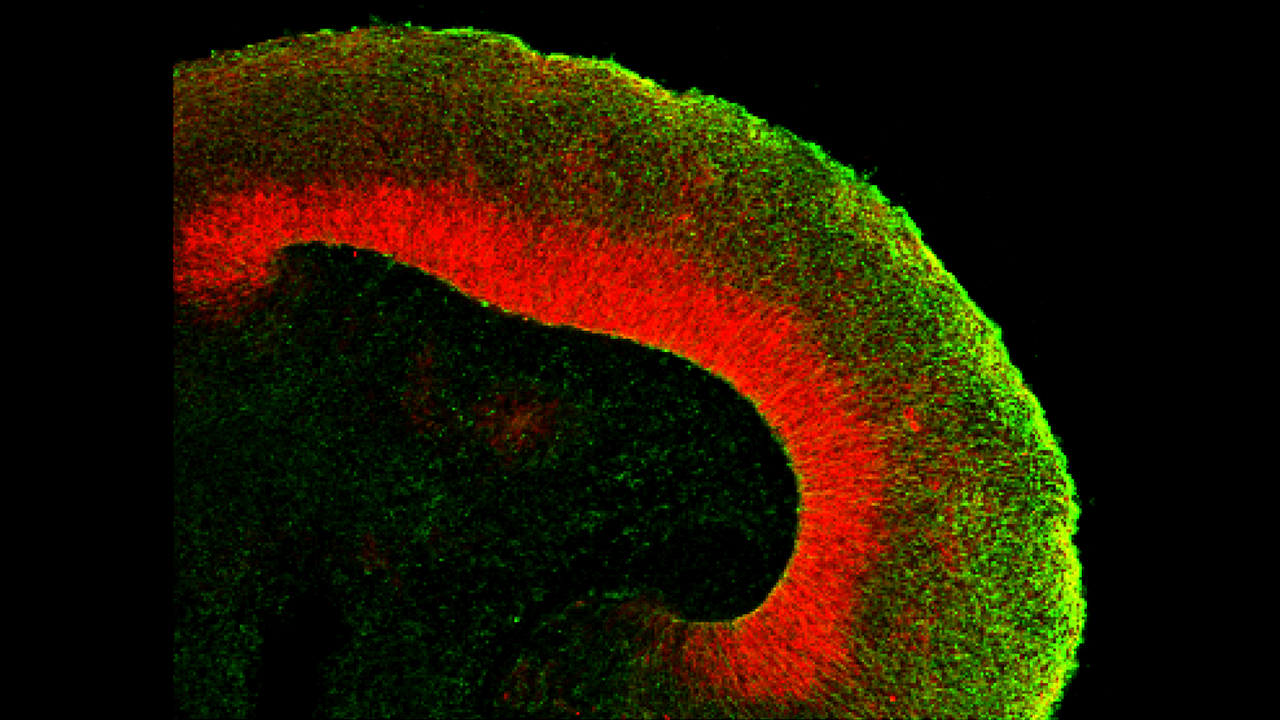Neural Induction and Differentiation of ESCs and iPSCs
Human pluripotent stem cells (hPSCs), including human embryonic stem (ES) cells and induced pluripotent stem (iPS) cells, are self-renewing cells that have the potential to develop into cells of all three germ layers, including the ectoderm. The ectoderm gives rise to the neural tube which includes all cells of the central nervous system including the brain. Since human brain tissue is hard to come by ES and iPS cells hold tremendous potential as a more representative model for studying human neurological development and disease. Being able to generate patient-specific differentiated cells bridges the gap between studies using animal models and clinical research.
We've created these resources to support your hPSC-derived neurological development and disease research, and to give you a window into the exciting research being done by others in the field.
Brains in a Dish: Using Cerebral Organoids to Study Human Brain Development and Disease
What are ‘mini-brains’, and how are they being used to study neurological development and disease? Dr. Oliver Wüseke, who works with cerebral organoids as a PostDoc in the Knoblich Lab at IMBA Vienna, gives an overview of the cerebral organoid field and discusses different techniques and results emerging as researchers increasingly adopt cerebral organoid technology to study brain development and disease.
View Now >-
 Rapidly Generating Functional Forebrain Neurons from hiPSCs Using an NGN2 mRNA-LNP PlatformIn this webinar, Robert Judson, Associate Director of Pluripotent Stem Cell Biology at ∫£Ω«∆∆Ω‚∞Ê Technologies, introduces a novel mRNA-LNP-based platform for rapidly generating forebrain neurons from human pluripotent stem cells (hPSCs). By leveraging NGN2 mRNA delivered via lipid nanoparticles, this approach offers a highly efficient and non-integrating alternative to traditional viral or transgenic overexpression systems. Compatible with multiple hPSC lines, STEMdiff‚Ñ¢-TF Forebrain Induced Neuron Kit enables researchers to generate functional Tuj1+ neurons in just five days.<br><br>As a supporter of, and participant in, ISSCR‚Äôs 2025 Annual Meeting, we share with you our presentation at ISSCR 2025. This presentation does not represent an endorsement from or support of the ISSCR.
Rapidly Generating Functional Forebrain Neurons from hiPSCs Using an NGN2 mRNA-LNP PlatformIn this webinar, Robert Judson, Associate Director of Pluripotent Stem Cell Biology at ∫£Ω«∆∆Ω‚∞Ê Technologies, introduces a novel mRNA-LNP-based platform for rapidly generating forebrain neurons from human pluripotent stem cells (hPSCs). By leveraging NGN2 mRNA delivered via lipid nanoparticles, this approach offers a highly efficient and non-integrating alternative to traditional viral or transgenic overexpression systems. Compatible with multiple hPSC lines, STEMdiff‚Ñ¢-TF Forebrain Induced Neuron Kit enables researchers to generate functional Tuj1+ neurons in just five days.<br><br>As a supporter of, and participant in, ISSCR‚Äôs 2025 Annual Meeting, we share with you our presentation at ISSCR 2025. This presentation does not represent an endorsement from or support of the ISSCR. -
 Advancing Neurological and Retinal Research with Genetically Diverse Human iPSC-Derived ModelsIn this webinar, Andrew Gaffney, Director of Stem Cell Manufacturing and Commercialization at ∫£Ω«∆∆Ω‚∞Ê Technologies, showcases how high-quality, genetically diverse iPSC lines and differentiated cells are advancing research in neurological and retinal diseases. Manufactured to meet ISSCR standards, these iPSC lines undergo extensive quality control, ensuring consistency and reliability for disease modeling and drug discovery. ∫£Ω«∆∆Ω‚∞Ê has optimized the differentiation of these iPSCs into mature, functional astrocytes and retinal pigment epithelial (RPE) cells that exhibit hallmark physiological behaviors.<br><br>As a supporter of, and participant in, ISSCR‚Äôs 2025 Annual Meeting, we share with you our presentation at ISSCR 2025. This presentation does not represent an endorsement from or support of the ISSCR.
Advancing Neurological and Retinal Research with Genetically Diverse Human iPSC-Derived ModelsIn this webinar, Andrew Gaffney, Director of Stem Cell Manufacturing and Commercialization at ∫£Ω«∆∆Ω‚∞Ê Technologies, showcases how high-quality, genetically diverse iPSC lines and differentiated cells are advancing research in neurological and retinal diseases. Manufactured to meet ISSCR standards, these iPSC lines undergo extensive quality control, ensuring consistency and reliability for disease modeling and drug discovery. ∫£Ω«∆∆Ω‚∞Ê has optimized the differentiation of these iPSCs into mature, functional astrocytes and retinal pigment epithelial (RPE) cells that exhibit hallmark physiological behaviors.<br><br>As a supporter of, and participant in, ISSCR‚Äôs 2025 Annual Meeting, we share with you our presentation at ISSCR 2025. This presentation does not represent an endorsement from or support of the ISSCR. -
 Applying the ISSCR Standards for Research CourseLearn to confidently apply the ISSCR Standards for Human Stem Cell Use in Research to your human pluripotent stem cell-based projects.
Applying the ISSCR Standards for Research CourseLearn to confidently apply the ISSCR Standards for Human Stem Cell Use in Research to your human pluripotent stem cell-based projects.










